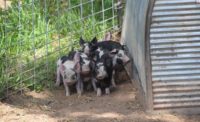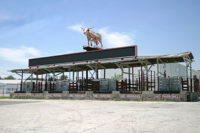Teachable moments in humane animal handling
Lessons from the 62 humane handling enforcement actions posted to the USDA’s Food Safety and Inspection Services website in 2021.

Summary
Within the 62 enforcement actions, most were related to cattle (48.4%; 30 of 62), followed by swine (40.3%; 25 of 62), sheep (6.5%; four of 62), and goats (4.8%; three of 62).
Regulatory choices
The Humane Methods of Slaughter Act of 1978 (7 U.S.C. SS 1901) and the regulations that enforce it (9 CFR 313) outline the regulation of humane handling and stunning of red-meat species. There are three primary categories in which the regulations in 9 CFR 313 can be divided: stunning, handling and facilities. Within our analyses, enforcement actions were classified as “multiple” if both handling and stunning events are involved within a single enforcement action, or if multiple animals are involved in a single enforcement action. The majority (82.3%; 51 of 62) of enforcement actions issued in 2021 were stunning-related, followed by multiple (12.9%; eight of 62), and handling (4.8%; three of 62). There were no facility-related enforcement actions in 2021.
After an alleged violation of 9 CFR 313 there are two primary actions that FSIS may take: notice of suspension (suspension) or notice of intended enforcement (NOIE). Suspension discontinues inspection services until the humane handling issue is appropriately addressed. Inspection may resume following a response that has been reviewed and approved by the corresponding FSIS district office. A NOIE is a warning which provides notification to an establishment that there is basis for FSIS to suspend inspection. However, a NOIE provides the establishment an opportunity to take immediate corrective action and future preventative actions without suspending inspection. If appropriate action is not taken within three business days, a NOIE can turn into a suspension. Suspensions accounted for 79% (49 of 62) of enforcement actions and NOIEs accounted or 9.7% of enforcement actions in 2021. In addition, 11.3% (seven of 62) enforcement actions in 2021 were classified as a reinstatement of suspension.
Follow-up actions to enforcement actions also include two primary options: abeyance or deferral. Abeyances mean that the enforcement action has been lifted, the establishment may operate under mutually agreed upon conditions, and that inspection may resume. An abeyance may be stated in one of two ways: suspension held in abeyance or reinstatement of suspension held in abeyance. Abeyances accounted for 88.7% (55 of 62) of all follow-up actions issued in 2021. In 2021, there was a single (1.6%; one of 62) reinstatement of suspension that did not report a follow-up action. A deferral is a follow-up action to a NOIE, and a letter of deferral is issued from the district office when an establishment has proposed adequate corrective and preventative actions. The follow-up action for all 6 NOIEs issued in 2021 was deferral, and deferrals accounted for 9.7% (six of 62) of all follow up-actions in 2021. It is important to note that after a follow-up action has been issued, FSIS may issue a suspension (in the case of a previous NOIE) or reinstatement of suspension (in the case of a previous suspension) if an establishment does not adequately address the humane handling concern(s) or if new concerns arise.
Handling
There were three handling-related enforcement actions, which comprised 4.8% of all enforcement actions in 2021. Handling-related enforcement actions include improper handling and the improper treatment of non-ambulatory animals but may also be a result of negligence to act on time-sensitive animal welfare concerns. Improper handling includes excessive electric prod use, use of electric prods in sensitive areas, kicking, hitting, and the use of inappropriate handling tools such as shovels or PVC pipes. Improper treatment of non-ambulatory animals may include anything listed as improper handling, in addition to dragging a live animal, or a delay in response to action involving an animal: either euthanasia or movement to a suspect pen, depending on the species. If a non-ambulatory animal is identified and euthanasia is the appropriate action to take, it should be done as reasonably close to immediately as possible by an individual trained in proper euthanasia methods appropriate for the situation. Improper treatment of non-ambulatory animals was the cause for two of the three handling-related enforcement actions; one involved an establishment employee dragging a non-ambulatory cow by the tail from a trailer and dropping her onto the ground and the other involved a non-ambulatory cow stuck in the knock box such that another cow climbed on top of her. The other handling related enforcement action involved an establishment employee picking up a sensible lamb and forcefully throwing the lamb against a fence.
Stunning
There were 51 stunning related enforcement actions in 2021. These enforcement actions comprised 82.3% of all enforcement actions. Mechanical stunning methods — captive bolt and gunshot — comprised the majority (86.0%; 43 of 50) of these enforcement actions, followed carbon dioxide stunning (8%; four of 50), and electrical stunning (6%; three of 50). There were no enforcement actions in 2021 involving ritual slaughter that were classified as stunning-related. The reason for stun failure was not clearly reported for 70.6% (36 of 51) enforcement actions. However, for the enforcement actions where a clear reason for stun failure was described, 21.6% (11 of 51) involved an issue with placement, 3.9% (two of 51) involved an issue with restraint, and 3.9% (two of 51) involved an issue with equipment. There were no stunning-related enforcement actions in 2021 that could be clearly attributed to too much time between stunning and exsanguination. Of the 43 enforcement actions related specifically to mechanical stunning in 2021, more involved captive bolt (55.8%; 24 of 43) than gunshot (41.9%; 18 of 43), while a single enforcement action (2.3%; one of 43) did not clearly specify what type of mechanical stunning was used.
Multiple issues
There were eight enforcement actions that were classified as ‘multiple’ in 2021. Four of these enforcement actions involved swine, two involved cattle and two involved goats. Together, these enforcement actions comprise 12.9% of all enforcement actions in 2021. The majority (seven) of the enforcement actions classified as ‘multiple’ involved an establishment employee making a cut on an animal that was unsuccessfully stunned and displaying signs of sensibility. It is important to emphasize that any animal that displays signs of sensibility at any time after stunning needs to be stunned immediately — proceeding to stick the animal is considered a violation of the Humane Methods of Slaughter Act and 9 CFR 313. The remaining enforcement action described multiple instances of ineffective stunning within a month.
It is important for establishments to review breakdowns in their processes with any enforcement action. However, this is critical in instances where multiple violations are reported within a single enforcement action. In these situations, it is important that management identify the root source of the issue — does it result from the level of tolerance from staff, lack of training for new employees, or lack of continuing education for current employees? Or are there large, ongoing issues at play? The identification of the root cause of these violations will not only help an establishment reinstate inspection and their ability to slaughter, but also improve handling and stunning methods to maintain a higher level of animal welfare and prevent future problems.
Where to start: Focus on training
Like previous years, the majority (82.3%) of enforcement actions issued by FSIS in 2021 were related to stunning. The number of stuns it took to effectively stun animals involved in these enforcement actions ranged from two to nine. Fortunately, there are ways to improve stunning outcomes:
- using equipment that is appropriate for the type of animal
- employing proper restraint methods
- and ensuring proper stun placement.
Training is vital to ensuring proper stun placement, and it may be useful to use heads from previously stunned animals to identify the location of the brain. These heads can also be used for stunning practice, especially with a captive bolt.
It is important that training for stunner operators is approached in a steps. The first step should involve instruction and observation, but the trainee should not be allowed to stun live animals. The second step should include practicing stuns to the heads of animals that have been stunned. These heads can be skinned or unskinned but should be split lengthwise with a band saw or head splitter so that the trainee can visualize the bolt path and brain location. Then, once trainees are ready to stun live animals, they should only be allowed to operate the stunner for short periods of time. The physical demands of stunning are high, so it is important that the training of stunner operators allows for their body to adjust to the rigors of the position. It is critical to check on the mental wellbeing of the stunner operators, as their job is also mentally draining. Good management can catch physical or mental fatigue and intervene before a crisis occurs.
The best way to prevent humane handling enforcement actions is to prevent violative incidents from occurring. It is important for establishments to have a robust systematic approach to animal welfare that utilizes a HACCP-like approach and following the procedures it outlines is a great way to prevent and avoid enforcement issued by FSIS related to the Humane Methods of Slaughter Act. A culture of diligence and ‘doing the right thing’ is important for everyone involved.
Karly N. Anderson, MS is a PhD student and graduate research assistant at the University of Nebraska – Lincoln and a research and teaching affiliate of the Animal Welfare Lab at the University of Wisconsin – River Falls.
Joie Haines is a pre-veterinary medicine, animal science undergraduate student at the University of Wisconsin – River Falls and a member of the Animal Welfare Lab.
Hannah Olsen is a master’s student and graduate research assistant at the University of Wisconsin – River Falls and a member of the Animal Welfare Lab and UWRF Animal Welfare Judging Team.
Dr. Kurt D. Vogel is an Associate Professor of Livestock Behavior and Welfare in the Animal and Food Science Department at the University of Wisconsin – River Falls. He is also the President of Vogel Livestock Solutions – a food animal welfare consulting company, if you have any questions or comments, you can reach out to Dr. Vogel by email: kurt.vogel@uwrf.edu or phone: (715) 425-4704.Looking for a reprint of this article?
From high-res PDFs to custom plaques, order your copy today!






